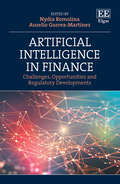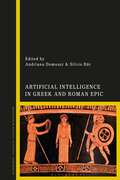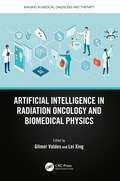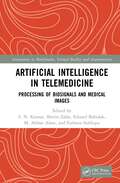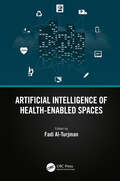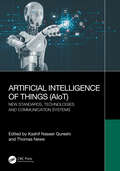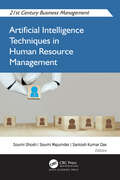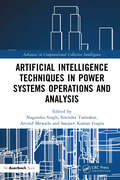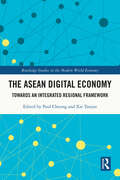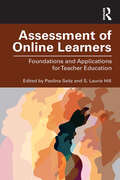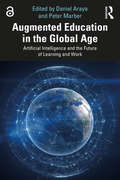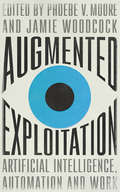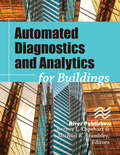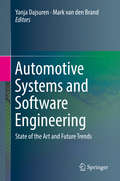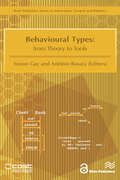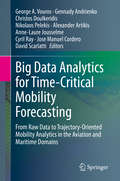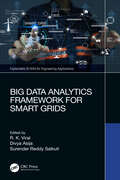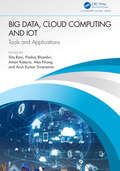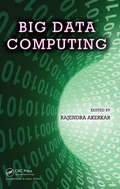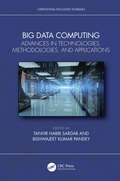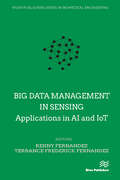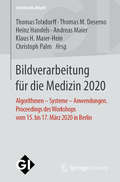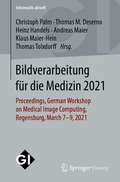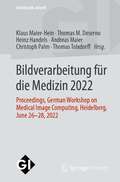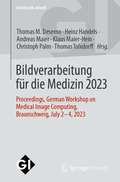- Table View
- List View
Artificial Intelligence in Finance: Challenges, Opportunities and Regulatory Developments
This book provides a comprehensive analysis of the primary challenges, opportunities and regulatory developments associated with the use of artificial intelligence (AI) in the financial sector. It will show that, while AI has the potential to promote a more inclusive and competitive financial system, the increasing use of AI may bring certain risks and regulatory challenges that need to be addressed by regulators and policymakers.After analysing the technological foundations of AI, the book focuses on the use and regulatory challenges of AI in the banking, capital markets and insurance industries. It also analyses, compares and assesses the different strategies and international approaches that have been adopted to address the challenges raised by the use of AI. The book concludes by providing a holistic and cross-sectoral analysis of the use of AI in the financial sector.The comprehensive, interdisciplinary, and industry-relevant approach adopted in Artificial Intelligence in Finance will provide students, practitioners and academics interested in financial markets with a broad understanding of the challenges and opportunities of AI in the financial sector. Additionally, the comparative and policy-oriented approach also adopted in the book will provide regulators and policymakers with innovative ideas and regulatory solutions that will help them address some of the most critical challenges associated with a new data-driven financial system.
Artificial Intelligence in Greek and Roman Epic
This is the first scholarly exploration of concepts and representations of Artificial Intelligence in ancient Greek and Roman epic, including their reception in later literature and culture. Contributors look at how Hesiod, Homer, Apollonius of Rhodes, Moschus, Ovid and Valerius Flaccus crafted the first literary concepts concerned with automata and the quest for artificial life, as well as technological intervention improving human life.Parts one and two consider, respectively, archaic Greek, and Hellenistic and Roman, epics. Contributors explore the representations of Pandora in Hesiod, and Homeric automata such as Hephaestus' wheeled tripods, the Phaeacian king Alcinous' golden and silver guard dogs, and even the Trojan Horse. Later examples cover Artificial Intelligence and automation (including Talos) in the Argonautica of Apollonius and Valerius Flaccus, and Pygmalion's ivory woman in Ovid's Metamorphoses. Part three underlines how these concepts benefit from analysis of the ekphrasis device, within which they often feature. These chapters investigate the cyborg potential of the epic hero and the literary implications of ancient technology. Moving into contemporary examples, the final chapters consider the reception of ancient literary Artificial Intelligence in contemporary film and literature, such as the Czech science-fiction epic Starvoyage, or Small Cosmic Odyssey by Jan Kr?esadlo (1995) and the British science-fiction novel The Holy Machine by Chris Beckett (2004).
Artificial Intelligence in Radiation Oncology and Biomedical Physics (Imaging in Medical Diagnosis and Therapy)
This pioneering book explores how machine learning and other AI techniques impact millions of cancer patients who benefit from ionizing radiation. It features contributions from global researchers and clinicians, focusing on the clinical applications of machine learning for medical physics. AI and machine learning have attracted much recent attention and are being increasingly adopted in medicine, with many clinical components and commercial software including aspects of machine learning integration. General principles and important techniques in machine learning are introduced, followed by discussion of clinical applications, particularly in radiomics, outcome prediction, registration and segmentation, treatment planning, quality assurance, image processing, and clinical decision-making. Finally, a futuristic look at the role of AI in radiation oncology is provided. This book brings medical physicists and radiation oncologists up to date with the most novel applications of machine learning to medical physics. Practitioners will appreciate the insightful discussions and detailed descriptions in each chapter. Its emphasis on clinical applications reaches a wide audience within the medical physics profession.
Artificial Intelligence in Telemedicine: Processing of Biosignals and Medical images (Innovations in Multimedia, Virtual Reality and Augmentation)
This book explores the role of artificial Intelligence in Telemedicine. It explains the concepts through the detailed study and processing of biosignals, physiological parameters, and medical images. The book focuses on computational algorithms in telemedicine for the processing of biosignals, physiological parameters, and medical Images. The book is presented in two section. The first section presents the role of computational algorithms in the processing of biosignal and medical images for disease diagnosis and treatment planning. Noise removal in ECG signal using an improved adaptive learning approach, classification of ECG signals using CNN for cardiac arrhythmia detection, EEG signal analysis for stroke detection, and EMG signal analysis for gesture classification were discussed in this section. Application of CNN in pertussis Diagnosis by temperature monitoring, physician handwriting recognition using deep learning model, melanoma detection using ABCD parameters, and transfer learning enabled heuristic approach for pneumonia detection was also discussed in this section The second section focus on the role of IoT and artificial intelligence in the healthcare sector. IoT in smart health care and applications of artificial intelligence in disease diagnosis and prediction was discussed in this section. The importance of 5G/6G in the pandemic scenario for telemedicine applications, wireless capsule endoscopy image compression, leukemia detection from the microscopic cell images, and genomic signal processing using numerical mapping techniques was also discussed in this section. This book can be used by a wide range of users including students, research scholars, faculty, and practitioners in the field of engineering for applications in biomedical signal, image analysis, and diagnosis.
Artificial Intelligence of Health-Enabled Spaces
Artificial Intelligence of Health-Enabled Spaces (AIoH) has made a number of revolutionary advances in clinical studies that we are aware of. Among these advances, intelligent and medical services are gaining a great deal of interest. Nowadays, AI-powered technologies are not only used in saving lives, but also in our daily life activities in diagnosing, controlling, and even tracking of COVID-19 patients. These AI-powered solutions are expected to communicate with cellular networks smoothly in the next-generation networks (5G/6G and beyond) for more effective/critical medical applications. This will open the door for other interesting research areas. This book focuses on the development and analysis of artificial intelligence (AI) model applications across multiple disciplines. AI-based deep learning models, fuzzy and hybrid intelligent systems, and intrinsic explainable models are also presented in this book. Some of the fields considered in this smart health-oriented book include AI applications in electrical engineering, biomedical engineering, environmental engineering, computer engineering, education, cyber security, chemistry, pharmacy, molecular biology, and tourism. This book is dedicated to addressing the major challenges in fighting diseases and psychological issues using AI. These challenges vary from cost and complexity to availability and accuracy. The aim of this book is hence to focus on both the design and implementation aspects of AI-based approaches in the proposed health-related solutions. Targeted readers are from varying disciplines who are interested in implementing the smart planet/environments vision via intelligent enabling technologies.
Artificial Intelligence of Things (AIoT): New Standards, Technologies and Communication Systems
This book is devoted to the new standards, technologies, and communication systems for Artificial Intelligence of Things (AIoT) networks. Smart and intelligent communication networks have gained significant attention due to the combination of AI and IoT networks to improve human and machine interfaces and enhance data processing and services. AIoT networks involve the collection of data from several devices and sensor nodes in the environment. AI can enhance these networks to make them faster, greener, smarter, and safer. Computer vision, language processing, and speech recognition are some examples of AIoT networks.Due to a large number of devices in today’s world, efficient and intelligent data processing is essential for problem-solving and decision-making. AI multiplies the value of these networks and promotes intelligence and learning capabilities, especially in homes, offices, and cities. However, several challenges have been observed in deploying AIoT networks, such as scalability, complexity, accuracy, and robustness. In addition, these networks are integrated with cloud, 5G networks, and blockchain methods for service provision. Many different solutions have been proposed to address issues related to machine and deep learning methods, ontology-based approaches, genetic algorithms, and fuzzy-based systems.This book aims to contribute to the state of the art and present current standards, technologies, and approaches for AIoT networks. This book focuses on existing solutions in AIoT network technologies, applications, services, standards, architectures, and security provisions. This book also introduces some new architectures and models for AIoT networks.
Artificial Intelligence Techniques in Human Resource Management (21st Century Business Management)
This new volume presents a range of techniques that aim to enhance the operation of human resource management by applying state-of-the-art artificial intelligence technology. With illustrative case studies, the volume uses examples from several real-life problems and includes their possible solutions using advanced AI technology. The book explores the confluence of smart computing and traditional businesses to foster productivity, profitability, and prosperity and goes on to apply AI techniques in the recruitment process, with enterprise resource planning management software, for manpower optimization systems in colleges, for creating uniformity in HRM across organizations, for creating conflicting strategy management techniques, and more. One pandemicrelated chapter discusses the use of radio frequency-based technology for monitoring social distancing.
Artificial Intelligence Techniques in Power Systems Operations and Analysis (Advances in Computational Collective Intelligence)
An electrical power system consists of a large number of generation, transmission, and distribution subsystems. It is a very large and complex system; hence, its installation and management are very difficult tasks. An electrical system is essentially a very large network with very large data sets. Handling these data sets can require much time to analyze and subsequently implement. An electrical system is necessary but also potentially very dangerous if not operated and controlled properly. The demand for electricity is ever increasing, so maintaining load demand without overloading the system poses challenges and difficulties. Thus, planning, installing, operating, and controlling such a large system requires new technology. Artificial intelligence (AI) applications have many key features that can support a power system and handle overall power system operations. AI-based applications can manage the large data sets related to a power system. They can also help design power plants, model installation layouts, optimize load dispatch, and quickly respond to control apparatus. These applications and their techniques have been successful in many areas of power system engineering. Artificial Intelligence Techniques in Power Systems Operations and Analysis focuses on the various challenges arising in power systems and how AI techniques help to overcome these challenges. It examines important areas of power system analysis and the implementation of AI-driven analysis techniques. The book helps academicians and researchers understand how AI can be used for more efficient operation. Multiple AI techniques and their application are explained. Also featured are relevant data sets and case studies. Highlights include: Power quality enhancement by PV-UPQC for non-linear load Energy management of a nanogrid through flair of deep learning from IoT environments Role of artificial intelligence and machine learning in power systems with fault detection and diagnosis AC power optimization techniques Artificial intelligence and machine learning techniques in power systems automation
The ASEAN Digital Economy: Towards an Integrated Regional Framework (Routledge Studies in the Modern World Economy)
Boasting the fastest growing Internet market in the world, Association of Southeast Asian Nations (ASEAN) is accelerating into the digital economy. This book assesses the potential economic impact of digital economy agreements (DEAs) and the readiness of some ASEAN member states to grow the digital economy in collaboration. The book presents a novel framework to assess countries’ readiness to enter digital economy collaborations, following the architecture of Singapore’s DEAs with its trading partners. It takes a bird’s-eye view of the digital economy in ASEAN and reviews the current state of digital infrastructure and regulations. The book also includes simulation exercises to project economic outcomes delivered by regional collaborations. It also elaborates on the specific strengths and weaknesses of five ASEAN member states. These ASEAN member states include Indonesia, Malaysia, the Philippines, Vietnam, and Cambodia. The book concludes by revisiting the ASEAN economy as a whole. It points out key issues country leaders need to work on as they proceed with digital economy collaborations. This book is written for scholars, policymakers, and industrial practitioners who wish to learn the latest developments in the ASEAN digital economy.
Assessment of Online Learners: Foundations and Applications for Teacher Education
Assessment of Online Learners offers essential foundations, insights, and real-world examples for preservice teachers preparing to assess students in today’s digitized classrooms. When aligned with intended curricula and best practices, assessment not only informs but enhances both instruction and student achievement, though the recent large-scale adaptation of face-to-face learning to online platforms has yielded new challenges and responsibilities for teachers. This book explores shifts in the research and practice of assessment in online environments, the reconceptualization of course content and assessment frameworks in teacher education, the collection of fair and accurate assessment evidence reflecting students’ virtual learning, and more. Drawing from experienced Canadian instructors who overcame the inherent technological obstacles, these chapters showcase how unprecedented changes in schooling can lead to pedagogical renewal, program reevaluation, and a broader understanding of instruction and assessment practices.
Augmented Education in the Global Age: Artificial Intelligence and the Future of Learning and Work
Augmented Education in the Global Age: Artificial Intelligence and the Future of Learning and Work is an edited collection that explores the social impact of Artificial Intelligence over the coming decades, specifically how this emerging technology will transform and disrupt our contemporary institutions. Chapters in this book discuss the history of technological revolutions and consider the anxieties and social challenges of lost occupations, as well as the evolution of new industries overlapping robotics, biotechnology, space exploration, and clean energy. Chapter authors unpack the nature of augmented education, from revamping curriculum and personalizing education, to redesigning workplace learning for an algorithmic era. Ultimately the book discusses policy and planning for an augmented future, arguing that work and learning are undergoing a metamorphosis around creativity and innovation amid a new global era and the race against automating technologies. Bringing together expert perspectives from around the world, this exciting, informative collection of research and analysis helps educators, policymakers and analysts navigate the future of work and learning amid rapid and accelerating technological change. The Open Access version of this book, available at http://www.taylorfrancis.com, has been made available under a Creative Commons Attribution-Non Commercial-No Derivatives (CC-BY-NC-ND) 4.0 license.
Augmented Exploitation: Artificial Intelligence, Automation and Work (Wildcat)
Artificial Intelligence is a seemingly neutral technology, but it is increasingly used to manage workforces and make decisions to hire and fire employees. Its proliferation in the workplace gives the impression of a fairer, more efficient system of management. A machine can't discriminate, after all. Augmented Exploitation explores the reality of the impact of AI on workers' lives. While the consensus is that AI is a completely new way of managing a workplace, the authors show that, on the contrary, AI is used as most technologies are used under capitalism: as a smokescreen that hides the deep exploitation of workers. Going beyond platform work and the gig economy, the authors explore emerging forms of algorithmic governance and AI-augmented apps that have been developed to utilise innovative ways to collect data about workers and consumers, as well as to keep wages and worker representation under control. They also show that workers are not taking this lying down, providing case studies of new and exciting form of resistance that are springing up across the globe.
Automated Diagnostics and Analytics for Buildings
With the widespread availability of high-speed, high-capacity microprocessors and microcomputers with high-speed communication ability, and sophisticated energy analytics software, the technology to support deployment of automated diagnostics is now available, and the opportunity to apply automated fault detection and diagnostics to every system and piece of equipment in a facility, as well as for whole buildings, is imminent. The purpose of this book is to share information with a broad audience on the state of automated fault detection and diagnostics for buildings applications, the benefits of those applications, emerging diagnostic technology, examples of field deployments, the relationship to codes and standards, automated diagnostic tools presently available, guidance on how to use automated diagnostics, and related issues.
Automotive Systems and Software Engineering: State of the Art and Future Trends
This book presents the state of the art, challenges and future trends in automotive software engineering. The amount of automotive software has grown from just a few lines of code in the 1970s to millions of lines in today’s cars. And this trend seems destined to continue in the years to come, considering all the innovations in electric/hybrid, autonomous, and connected cars. Yet there are also concerns related to onboard software, such as security, robustness, and trust.This book covers all essential aspects of the field. After a general introduction to the topic, it addresses automotive software development, automotive software reuse, E/E architectures and safety, C-ITS and security, and future trends. The specific topics discussed include requirements engineering for embedded software systems, tools and methods used in the automotive industry, software product lines, architectural frameworks, various related ISO standards, functional safety and safety cases, cooperative intelligent transportation systems, autonomous vehicles, and security and privacy issues.The intended audience includes researchers from academia who want to learn what the fundamental challenges are and how they are being tackled in the industry, and practitioners looking for cutting-edge academic findings. Although the book is not written as lecture notes, it can also be used in advanced master’s-level courses on software and system engineering. The book also includes a number of case studies that can be used for student projects.
Behavioural Types: From Theory to Tools
Behavioural type systems in programming languages support the specification and verification of properties of programs beyond the traditional use of type systems to describe data processing. A major example of such a property is correctness of communication in concurrent and distributed systems, motivated by the importance of structured communication in modern software. Behavioural Types: from Theory to Tools presents programming languages and software tools produced by members of COST Action IC1201: Behavioural Types for Reliable Large-Scale Software Systems, a European research network that was funded from October 2012 to October 2016. As a survey of the most recent developments in the application of behavioural type systems, it is a valuable reference for researchers in the field, as well as an introduction to the area for graduate students and software developers.
Big Data Analytics for Time-Critical Mobility Forecasting: From Raw Data to Trajectory-Oriented Mobility Analytics in the Aviation and Maritime Domains
This book provides detailed descriptions of big data solutions for activity detection and forecasting of very large numbers of moving entities spread across large geographical areas. It presents state-of-the-art methods for processing, managing, detecting and predicting trajectories and important events related to moving entities, together with advanced visual analytics methods, over multiple heterogeneous, voluminous, fluctuating and noisy data streams from moving entities, correlating them with data from archived data sources expressing e.g. entities’ characteristics, geographical information, mobility patterns, mobility regulations and intentional data. The book is divided into six parts: Part I discusses the motivation and background of mobility forecasting supported by trajectory-oriented analytics, and includes specific problems and challenges in the aviation (air-traffic management) and the maritime domains. Part II focuses on big data quality assessment and processing, and presents novel technologies suitable for mobility analytics components. Next, Part III describes solutions toward processing and managing big spatio-temporal data, particularly enriching data streams and integrating streamed and archival data to provide coherent views of mobility, and storing of integrated mobility data in large distributed knowledge graphs for efficient query-answering. Part IV focuses on mobility analytics methods exploiting (online) processed, synopsized and enriched data streams as well as (offline) integrated, archived mobility data, and highlights future location and trajectory prediction methods, distinguishing between short-term and more challenging long-term predictions. Part V examines how methods addressing data management, data processing and mobility analytics are integrated in big data architectures with distinctive characteristics compared to other known big data paradigmatic architectures. Lastly, Part VI covers important ethical issues that research on mobility analytics should address. Providing novel approaches and methodologies related to mobility detection and forecasting needs based on big data exploration, processing, storage, and analysis, this book will appeal to computer scientists and stakeholders in various application domains.
Big Data Analytics Framework for Smart Grids (Explainable AI (XAI) for Engineering Applications)
The text comprehensively discusses smart grid operations and the use of big data analytics in overcoming the existing challenges. It covers smart power generation, transmission, and distribution, explains energy management systems, artificial intelligence, and machine learning–based computing. •Presents a detailed state-of-the-art analysis of big data analytics and its uses in power grids. • Describes how the big data analytics framework has been used to display energy in two scenarios including a single house and a smart grid with thousands of smart meters. •Explores the role of the internet of things, artificial intelligence, and machine learning in smart grids. • Discusses edge analytics for integration of generation technologies, and decision-making approaches in detail. • Examines research limitations and presents recommendations for further research to incorporate big data analytics into power system design and operational frameworks. &nb
Big Data, Cloud Computing and IoT: Tools and Applications
Cloud computing, the Internet of Things (IoT), and big data are three significant technological trends affecting the world's largest corporations. This book discusses big data, cloud computing, and the IoT, with a focus on the benefits and implementation problems. In addition, it examines the many structures and applications pertinent to these disciplines. Also, big data, cloud computing, and the IoT are proposed as possible study avenues. Features: Informs about cloud computing, IoT and big data, including theoretical foundations and the most recent empirical findings Provides essential research on the relationship between various technologies and the aggregate influence they have on solving real-world problems Ideal for academicians, developers, researchers, computer scientists, practitioners, information technology professionals, students, scholars, and engineers exploring research on the incorporation of technological innovations to address contemporary societal challenges
Big Data Computing
Due to market forces and technological evolution, Big Data computing is developing at an increasing rate. A wide variety of novel approaches and tools have emerged to tackle the challenges of Big Data, creating both more opportunities and more challenges for students and professionals in the field of data computation and analysis. Presenting a mix
Big Data Computing: Advances in Technologies, Methodologies, and Applications (Computational Intelligence Techniques)
This book primarily aims to provide an in-depth understanding of recent advances in big data computing technologies, methodologies, and applications along with introductory details of big data computing models such as Apache Hadoop, MapReduce, Hive, Pig, Mahout in-memory storage systems, NoSQL databases, and big data streaming services such as Apache Spark, Kafka, and so forth. It also covers developments in big data computing applications such as machine learning, deep learning, graph processing, and many others. Features: Provides comprehensive analysis of advanced aspects of big data challenges and enabling technologies. Explains computing models using real-world examples and dataset-based experiments. Includes case studies, quality diagrams, and demonstrations in each chapter. Describes modifications and optimization of existing technologies along with the novel big data computing models. Explores references to machine learning, deep learning, and graph processing. This book is aimed at graduate students and researchers in high-performance computing, data mining, knowledge discovery, and distributed computing.
Big data management in Sensing: Applications in AI and IoT
The book is centrally focused on human computer Interaction and how sensors within small and wide groups of Nano-robots employ Deep Learning for applications in industry. It covers a wide array of topics that are useful for researchers and students to gain knowledge about AI and sensors in nanobots. Furthermore, the book explores Deep Learning approaches to enhance the accuracy of AI systems applied in medical robotics for surgical techniques. Secondly, we plan to explore bio-nano-robotics, which is a field in nano-robotics, that deals with automatic intelligence handling, self-assembly and replication, information processing and programmability.
Bildverarbeitung für die Medizin 2020: Algorithmen – Systeme – Anwendungen. Proceedings des Workshops vom 15. bis 17. März 2020 in Berlin (Informatik aktuell)
In den letzten Jahren hat sich der Workshop "Bildverarbeitung für die Medizin" durch erfolgreiche Veranstaltungen etabliert. Ziel ist auch 2020 wieder die Darstellung aktueller Forschungsergebnisse und die Vertiefung der Gespräche zwischen Wissenschaftlern, Industrie und Anwendern. Die Beiträge dieses Bandes - einige davon in englischer Sprache - umfassen alle Bereiche der medizinischen Bildverarbeitung, insbesondere Bildgebung und -akquisition, Maschinelles Lernen, Bildsegmentierung und Bildanalyse, Visualisierung und Animation, Zeitreihenanalyse, Computerunterstützte Diagnose, Biomechanische Modellierung, Validierung und Qualitätssicherung, Bildverarbeitung in der Telemedizin u.v.m.
Bildverarbeitung für die Medizin 2021: Proceedings, German Workshop on Medical Image Computing, Regensburg, March 7-9, 2021 (Informatik aktuell)
In den letzten Jahren hat sich der Workshop "Bildverarbeitung für die Medizin" durch erfolgreiche Veranstaltungen etabliert. Ziel ist auch 2021 wieder die Darstellung aktueller Forschungsergebnisse und die Vertiefung der Gespräche zwischen Wissenschaftlern, Industrie und Anwendern. Die Beiträge dieses Bandes - einige davon in englischer Sprache - umfassen alle Bereiche der medizinischen Bildverarbeitung, insbesondere Bildgebung und -akquisition, Maschinelles Lernen, Bildsegmentierung und Bildanalyse, Visualisierung und Animation, Zeitreihenanalyse, Computerunterstützte Diagnose, Biomechanische Modellierung, Validierung und Qualitätssicherung, Bildverarbeitung in der Telemedizin u.v.m.
Bildverarbeitung für die Medizin 2022: Proceedings, German Workshop on Medical Image Computing, Heidelberg, June 26-28, 2022 (Informatik aktuell)
In den letzten Jahren hat sich der Workshop "Bildverarbeitung für die Medizin" durch erfolgreiche Veranstaltungen etabliert. Ziel ist auch 2022 wieder die Darstellung aktueller Forschungsergebnisse und die Vertiefung der Gespräche zwischen Wissenschaftlern, Industrie und Anwendern. Die Beiträge dieses Bandes - einige davon in englischer Sprache - umfassen alle Bereiche der medizinischen Bildverarbeitung, insbesondere Bildgebung und -akquisition, Maschinelles Lernen, Bildsegmentierung und Bildanalyse, Visualisierung und Animation, Zeitreihenanalyse, Computerunterstützte Diagnose, Biomechanische Modellierung, Validierung und Qualitätssicherung, Bildverarbeitung in der Telemedizin u.v.m.
Bildverarbeitung für die Medizin 2023: Proceedings, German Workshop on Medical Image Computing, Braunschweig, July 2-4, 2023 (Informatik aktuell)
Seit mehr als 25 Jahren ist der Workshop "Bildverarbeitung für die Medizin" als erfolgreiche Veranstaltung etabliert. Ziel ist auch 2023 wieder die Darstellung aktueller Forschungsergebnisse und die Vertiefung der Gespräche zwischen Wissenschaftlern, Industrie und Anwendern. Die Beiträge dieses Bandes - viele davon in englischer Sprache - umfassen alle Bereiche der medizinischen Bildverarbeitung, insbesondere die Bildgebung und -akquisition, Segmentierung und Analyse, Visualisierung und Animation, computerunterstützte Diagnose sowie bildgestützte Therapieplanung und Therapie. Hierbei kommen Methoden des maschinelles Lernens, der biomechanischen Modellierung sowie der Validierung und Qualitätssicherung zum Einsatz.
